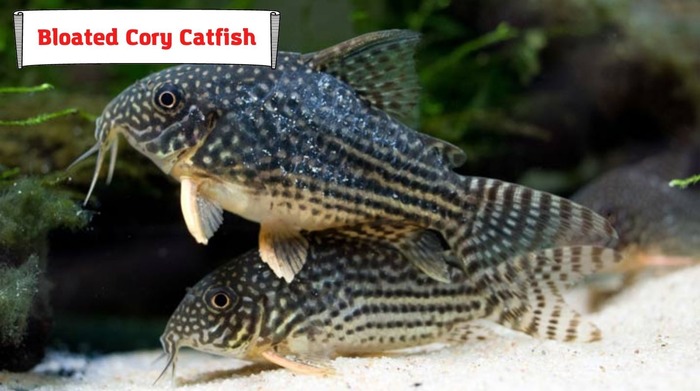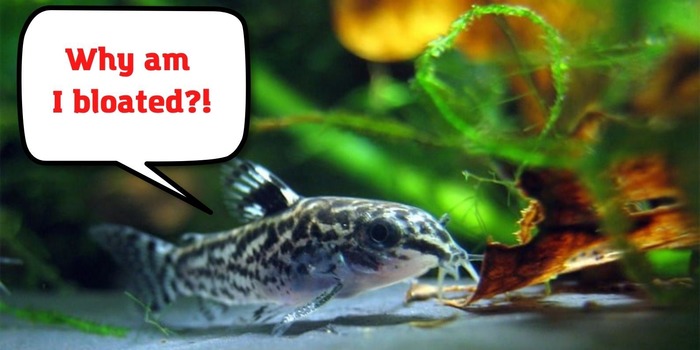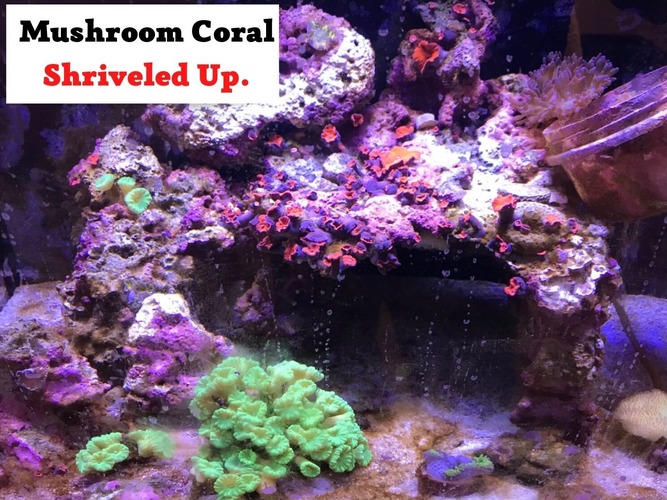
When you think of Cory Catfish, you think of a cute little creature with diverse types and lots of personalities. Their peaceful nature, ability to clean out the tank, and aesthetics usually attract aquarium hobbyists to this species. So, what does it mean when your Cory catfish becomes bloated?
The petite size and attractive physique are some of the things that catch the attention of aquarists. So, what does it mean when your Cory catfish becomes bloated and shapeless?
This article explains three likely reasons your Cory catfish are bloated. Also, it gives insight into some niggling questions you may have about the implications of the shape of your Cory catfish.
Thus, at the end of this post, you will be adequately aware of the reasons your Cory catfish is bloated. Also, the causes of bloats and tips you use to make things better for your Cory catfish will be explained explicitly. Preventive measures to avoid this headache are also available to help raise a healthy Cory catfish.
Let’s get started!
About Cory catfish
Cory catfish belong to the family of Callichthyidae, are omnivores, and have their scientific name as Corydoras. They are native to South America and prefer the slow-moving water flow like ponds and streams. They are nocturnal and bottom dwellers that love to hide and rest during the day. At night, they like to stay active and bubbly.
Occasionally, they leave the bottom of the tank to the surface to get some air. Suppose you notice that it indicates that the oxygen level in the water is low. But they sometimes come out to the surface when the oxygen level in the water is good.
Your Cory catfish usually won’t harm or prey on their tank mates. They are peaceful animals. The most they can do is hide when they sense any threat around. They make a great pair with other harmless species.
Cory catfish have a short face, a flat underside, and pectoral fins that protrude and rest on the surface. They also have three pairs of barbels (or whiskers) on their face. They use their barbels to detect food and navigate their way in the dark.
Some types of Cory catfish include; Albino Cory Catfish, Panda Cory Catfish, Green Cory Catfish, Peppered Cory Catfish, Pygmy Cory Catfish, Julii Cory Catfish, Emerald Cory Catfish, and Sterbai Cory Catfish.
Why is My Cory Catfish Bloated?

A bloated cory catfish usually has a noticeable large abdomen that suddenly emerges. If this sounds like your cory catfish, it is bloated. Things become generally difficult for a cory catfish if it is inflated. Usually, it will have problems swimming or floating correctly because of its swollen stomach. You will also find your cory catfish staying at the top of the tank more than usual or even descending to the bottom and not coming up. All of these symptoms are proof that your fish is bloated.
There are various reasons your Cory catfish is bloated. These reasons are discussed below.
Overfeeding
Healthy Cory catfish are usually slender and streamlined. This body type makes it easy for them to swim in the water freely. When you feed your fish too much, overfeeding is likely to cause them to bloat. Overfeeding can also cause excess fat to build up in their body and weigh on their organs. In the worst-case scenario, it can cause your fish to develop digestive issues.
Overfeeding does more than cause your Cory catfish to bloat. It reduces the water quality and creates stressful conditions that can make your fish vulnerable to diseases or death. It would be best to feed your Cory catfish small amounts of food multiple times every day to keep it in good shape and health.
Pregnancy
If your catfish with a swollen stomach is a female, there is a probability that she is about to lay eggs to give birth to young ones. In this case, you don’t have to worry so much about your fish. All you need to do is provide constant food, ensure the proper water parameters and maintain a check-up routine to ensure that nothing surprising happens.
It is crucial to ensure that your Cory catfish is at least 2.5 inches long before going ahead to breed them. This is the standard premise to determine their maturity since all fish mature differently. You can breed your fish any time you want.
However, there are some preparations to make before proceeding to breed your catfish. They include: selecting a healthy catfish, finding the perfect position to place the secluded tank for breeding (a quiet and dark area where the lighting system can be controlled). Also, you need to install a hiding spot in the tank for your catfish and make sure that all other essentials are provided in the tank.
Cory catfish are social creatures, so you need to breed as many couples as you can. This helps them stay active all through the breeding period.
Another important aspect of breeding Cory catfish is to make sure that you separate the mother from the eggs as soon as the eggs are laid. It is necessary because Corydoras eat their eggs. Separating the mother and eggs will keep the eggs safe to hatch correctly.
Identifying a pregnant Cory catfish from a Sick Cory Catfish

For a pregnant Cory catfish, you will notice that it still goes about its daily business despite the bloat. There will hardly be a sign of abnormality or unusual behavioral patterns about it.
This will not be the same for a sick, bloated fish. Close attention to these few details will help you decide if the bloat is a cause for concern.
It is improbable that you will discover this difference in a day. It would be best to monitor and inspect your Cory catfish for some weird behavioral patterns before reaching a concrete conclusion. These abnormal behavioral patterns may include:
- crashing at the bottom of the tank;
- locking their fins at their side;
- swimming frantically without any destination;
- rubbing their body on decorations in the tank like on gravel or rocks.
Ideally, it would be best if you waited for a few days to see these symptoms or the symptoms of a sick, bloated fish before reaching a final decision.
Dropsy
Dropsy is another likely reason your fish is bloated. It is the compilation of fluid in a fish’s body that triggers physical evidence through swelling of the stomach. Dropsy does not stem from one source. Many things can cause dropsy.
Aeromonas bacteria are one of the most notorious causes of dropsy in fish. These bacteria cause fatal damage to fish with weak immune systems. Other causes include:
- poor water chemistry;
- an increase of ammonia or nitrate;
- physical damage to the swim bladder;
- infections;
- stress from aggressive tank mates or transportation;
- weak immune system;
- a noticeable drop in the water temperature;
- improper nutrition;
- other diseases.
Prevention
You can ensure that your Cory catfish does not bloat or fall sick by following some simple procedures. It would be best to prevent things that stress your fish unnecessarily. Do your best to provide good water quality with the proper ammonia, nitrate, pH, and temperature levels. Ensure that you change the water regularly, test the aquarium to ensure it is habitable and healthy enough for your fish, and clean the filters frequently.
It will also help if you do not overfeed your fish. Make sure that flake foods don’t extend more than one month upon opening it. Do not overcrowd the tank. Endeavor to regularly remove waste from the tank’s bottom with a gravel vacuum.
Treatment
The regular advice is to separate the affected fish from the others. In extreme cases, euthanasia is the best solution to end the pain on your part and that of the fish. But, if it is still at its early stage, you may be able to save your fish. It would help if you directed the treatment to correct the root cause and give adequate support and care to your sick fish.
Here are some tips you need to help heal your catfish. First, you should isolate the sick fish in a quarantine tank. After separating the fish, you must add a teaspoon of salt per gallon of water to the tank and feed your fish fresh and high-quality foods. Include antibiotics in the diet of the sick fish (put it in either the water or food), and test the water regularly to ensure that it is appropriate for your fish. In a few days, your fish should be restored to good health.
Conclusion
Everything counts if you want your Cory catfish to live a healthy life. You have to be very careful not to indulge your fish too much and always be on the lookout for any symptom of sickness. Do everything proportionally so that your fish does not suffer from your overwhelming act of love.
In addition, ensure proper maintenance of the aquarium, don’t overfeed your fish, and check it regularly. Your fish is less likely to become ill at once. It is a gradual process. So, take note of every change and take precautions on time so that your Cory catfish can be with you for a long time.
- Snail Mantle Collapse – Here’s What Every Pet Owner Should Know - April 2, 2023
- Algaefix Killed My Fish – What Have I Done Wrong? - March 2, 2023
- How Long Can Live Rock Be Out of Water? And What Will Happen Then? - February 2, 2023




